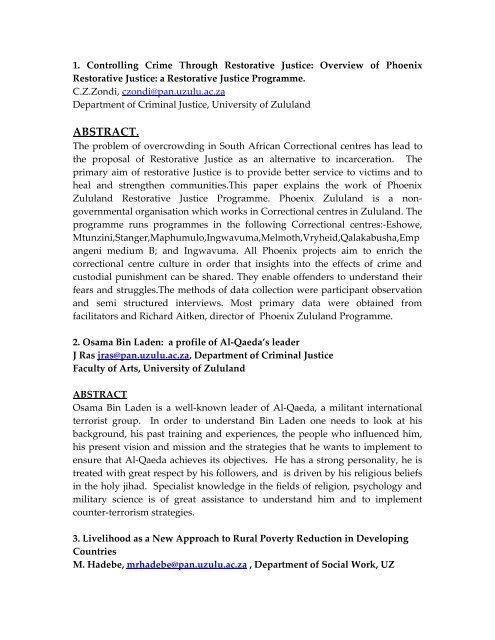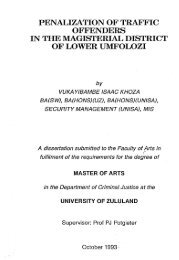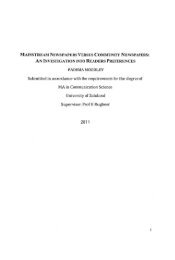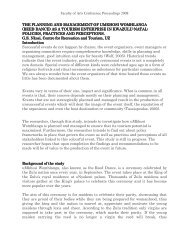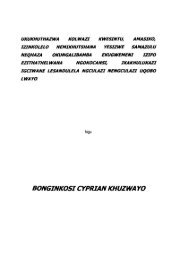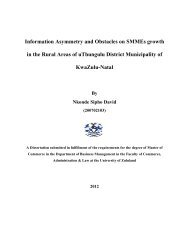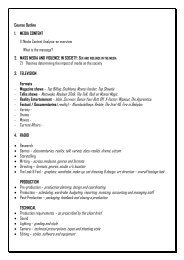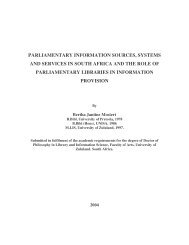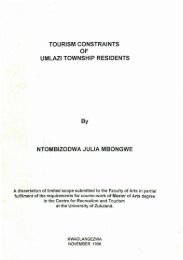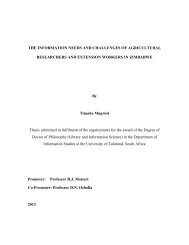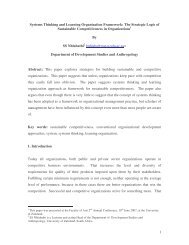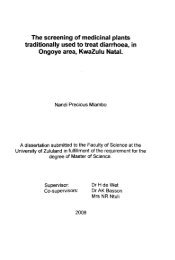Abstracts Arts faculty conference 2009 Edited Sept 11.pdf
Abstracts Arts faculty conference 2009 Edited Sept 11.pdf
Abstracts Arts faculty conference 2009 Edited Sept 11.pdf
Create successful ePaper yourself
Turn your PDF publications into a flip-book with our unique Google optimized e-Paper software.
1. Controlling Crime Through Restorative Justice: Overview of PhoenixRestorative Justice: a Restorative Justice Programme.C.Z.Zondi, czondi@pan.uzulu.ac.zaDepartment of Criminal Justice, University of ZululandABSTRACT.The problem of overcrowding in South African Correctional centres has lead tothe proposal of Restorative Justice as an alternative to incarceration. Theprimary aim of restorative Justice is to provide better service to victims and toheal and strengthen communities.This paper explains the work of PhoenixZululand Restorative Justice Programme. Phoenix Zululand is a nongovernmentalorganisation which works in Correctional centres in Zululand. Theprogramme runs programmes in the following Correctional centres:‐Eshowe,Mtunzini,Stanger,Maphumulo,Ingwavuma,Melmoth,Vryheid,Qalakabusha,Empangeni medium B; and Ingwavuma. All Phoenix projects aim to enrich thecorrectional centre culture in order that insights into the effects of crime andcustodial punishment can be shared. They enable offenders to understand theirfears and struggles.The methods of data collection were participant observationand semi structured interviews. Most primary data were obtained fromfacilitators and Richard Aitken, director of Phoenix Zululand Programme.2. Osama Bin Laden: a profile of Al‐Qaeda’s leaderJ Ras jras@pan.uzulu.ac.za, Department of Criminal JusticeFaculty of <strong>Arts</strong>, University of ZululandABSTRACTOsama Bin Laden is a well‐known leader of Al‐Qaeda, a militant internationalterrorist group. In order to understand Bin Laden one needs to look at hisbackground, his past training and experiences, the people who influenced him,his present vision and mission and the strategies that he wants to implement toensure that Al‐Qaeda achieves its objectives. He has a strong personality, he istreated with great respect by his followers, and is driven by his religious beliefsin the holy jihad. Specialist knowledge in the fields of religion, psychology andmilitary science is of great assistance to understand him and to implementcounter‐terrorism strategies.3. Livelihood as a New Approach to Rural Poverty Reduction in DevelopingCountriesM. Hadebe, mrhadebe@pan.uzulu.ac.za , Department of Social Work, UZ
ABSTRACTLivelihood and diversification have become popular topics in developmentstudies. Livelihood seems to offer a more complete picture of the complexities ofsurvival in low‐income countries than terms formerly considered adequate, like‘subsistence’, ‘income’ and ‘employment.’ Diversification recognizes that peoplesurvive by doing many different things, rather than just one thing or a fewthings. The purpose of this paper is to discuss the livelihood approach as one ofthe best strategies to rural poverty reduction. Diversification will then be broughtas a key theme within the livelihoods framework. Further, the paper willhighlight that farming on its own does not provide a sufficient means of survivalin rural areas, since it has been observed that most rural households are found todepend on a diverse portfolio of activities for the sources of income in order tocontribute to family well being. Thus, emphasise will be based on the fact thatlivelihood diversity has both economic and social dimensions and therefore,must be approached in an interdisciplinary way.4. The use of African languages such as isiZulu in contemporary Germanpopular novels set in AfricaDoret Jordaan,sjordaan@pan.uzulu.ac.za Department of German, University ofZululandABSTRACT:This paper will focus on the portrayal of language as well as the acquisition oflanguage as a motif in selected contemporary German novels set in Africa.Several motifs, such as the portrayal of certain main characters, are repeated invarious popular novels written in the German language. The popularity of manyGerman Bestsellers, set in Africa, is not only owing to the popularity of Africaitself as a setting, but also to the portrayal of many popular characters and theusage of certain descriptive techniques together with the entertainment value ofdrama and suspense. The aim of this paper is to show where the portrayalof indigenous languages fits ‐ as the German contemporary novels set in Africaaim to provide the greatest amount of entertainment to the largest number ofreaders5. A theo‐centric view on prostitutionMathinyane Winkie Tjelele‐Mqaise
mmqaise@pan.uzulu.ac.za ,Department of Psychology, University of ZululandABSTRACTIf we are to understand prostitution we need to understand how interrelated weare. In looking at interrelatedness it is difficult to consider aspects ofinterrelatedness without starting with the foundation of life. Therefore, toillustrate the latter, the illustration becomes incomplete without mentioningmankind (human beings) globally and mankind individually. To simplify thefoundation of life that would encompass the first umbrella layer of the rainbowas the connection to God, i.e. human beings are interrelated because they are thesame globally; created in the image of God. The second layer of the rainbow, theglobal connection encompassing the societal interrelatedness, within and outsideof societies comprising of communities and small family units connects directlyto the first. Finally, the last layer is the building block of the second umbrellalayer of the rainbow, the individual, male and female. Central to the family bodystructure formed by males and females are relationships which are intimate orfalse; but never meant to dominate either gender.6. Challenges of sustainable rural tourism development and implementationin the rural areas of KwaZulu‐NatalThandi A. Nzama ,atnzama@pan.uzulu.ac.zaDepartment of Recreation and Tourism,UZABSTRACTTourism has emerged as one of the strategic instruments and policy tools forcommunity and regional development in Southern Africa (Rogerson, 2007 inSaarinen et al <strong>2009</strong>). Gradually, tourism is rotating to the political centre stage asan instrument of social and economic empowerment (Binns & Nel, 2002;Scheyvens, 2002). Consequently, local government authorities have institutedinitiatives for promoting tourism as a sustainable economic driver in theirmunicipalities. Sustainable tourism development is widely supported because itdoes not threaten the integrity of the ecological and social systems upon whichcommunities and societies are dependent. The requirements for the successfulimplementation of sustainable tourism development are integrated planning,and the social learning process. The political viability of sustainable tourismdepends on the full support of the people it affects through their social structuresand private activities (Wahab, 2000). It is evident that sustainable tourism cannotbe successfully implemented without the direct support and involvement of
those who are affected by it. It is therefore essential that the community’ssensitivity to tourism development becomes the first step in planning forsustained tourism development. Marien and Pizam in Wahab & Pigram(2000:165) argue that since communities are constantly changing like the natureof tourism, evaluating community’s sensitivity and associated impacts shouldnot be regarded as an temporary event but as an ongoing process. TheNtambanana Municipality seeks to promote rural tourism in an attempt to maketourism more rewarding to the loal communities.Fundamentally, this study focuses on the strategic development of sustainabletourism in the rural areas of KwaZulu‐Natal. The objectives of the studyincluded: (a) Identifying the potential of tourism as contributing to ruraldevelopment (b) Identify potential tourist attractions found in rural areas; (c)Finding ways through which social awareness of the significance of participatingin tourism development could be enhanced. (c) Identifying challenges thatimpede sustainable rural tourism development and implementation. Data froma sample size of 320 were collected and analysed using the SPSS programme.7. The HIV/AIDS impasse as a consequence of ideologies resulting fromgender perceptionCandice Austin and Eva Latecka ,candipill@gmail.com Department ofPhilosophy, University of ZululandABSTRACTIn this paper, the authors examine the correlation between the continuing socioeconomicdisempowerment of South African women and the relative failure ofthe various campaigns to curb the HIV/AIDS pandemic. They claim that,primarily, it is the prevailing ideologies as to what it is to be a woman or a manthat are responsible for the uncontrollable spread of the virus. It is furtherclaimed that, while educational and awareness campaigns are valuable, a moredependable and durable effect can only be achieved through the changes in themindset and worldview of the whole population. In order to support the claim,the concept of an ideology as a belief or a set of beliefs which reconcile thebeliever with her/his disempowerment is discussed. It is argued that theideologies have an equally intense effect on women and men. Thus, it isimperative that an effective solution should involve a change in the mindset ofthe members of the society, both male and female. This change should entail apersonal transformation of one’s identity in relation to gender perception,leading to a societal paradigm shift.
8. Distress and turmoil: contribution to the theory of learning from existentialphenomenologyEva Latecka, elateck1@pan.uzulu.ac.za , Department of PhilosophyUniversity of ZululandABSTACTIn the paper the author shows how the effectiveness, retention, and“permanency” of learning depend on the “existential crisis” which the learnerhas to encounter, and a change in the learner’s identity resulting from his/herdealing with the crisis. The author achieves this goal by first presenting twoexamples, “case studies”. She then analyses them applying the philosophicalapproach of the existential phenomenologist Maurice Merleau‐Ponty. In order toaccount for the identity change, she also employs the concept of “ego‐states”.9 Indigenous African languages under siege: the case of Malawian languagesand some Southern African languagesThemba Moyoctmoyo@pan.uzulu.ac.za ,Department of General Linguistics, UZABSTRACTThe paper presents the language situation in Malawi and gives a broad picture ofa similar lamentable fate of indigenous languages in some Southern Africanstates. The norm of the functional usage of languages in a multilingual settingtoday is that all viable languages should be used in order to get services by allcitizens, unlike in the UK, where English alone is the official language. In theUSA too, where more than 40million citizens speak Spanish, English aloneremains the official language. The main contention is that in Malawi, like in theentire Southern African states, each of the indigenous African languages is ameans of expressing each community’s lives, in aspects of life: thoughts, ideas,etc.What is clearly observed is that in Malawi and the rest of Southern African states,indigenous African languages are used by the majority in their day‐to‐dayinteraction and these are the languages that citizens understand. The main focusof the discussion is that the choice of a European language, which enjoys themost prestigious role, by default in an independent state, is misplaced,discrimitory to the majority of the citizenry, who do not speak or understand
English and, therefore, democratically not equitable, if we consider thefundamental principle of human rights and language rights issues in fulfillingeducation, and socio‐economic life for all. The choice of an ex‐colonial language,ostensibly as a neutral language is false, as such a choice is only for the few elite.Choosing such a language, English or Portuguese as the most powerful officiallanguage, has resulted in creating a small, but very powerful ‘ethnic group’ ofEnglish or Portuguese speakers, with the rest of indigenous languagesmarginalised as the majority do not have access to services. In the end these excoloniallanguages have become gatekeepers of social mobility. Such languagepolicies are, therefore, misguided and not sufficiently relevant. The central ideais to formulate and implement the right policies, not instead, but in addition toEuropean languages.10. The Root Causes of the Conflict between the African National Congress(ANC) and the Inkatha Freedom Party (IFP) – a Struggle that Lasted for morethan a Quarter of a CenturyH.S. Ntuli, hntuli@pan.uzulu.ac.za , HistoryABSTRACTIn terms of the past political conflict KwaZulu Natal (KZN) has a reputation asthe province in South Africa in which the manifestation of violence was the mostsevere. Violence and its impact have negatively affected the lives of individualsand communities in the province in many ways. Violence was mainly causeddue to stormy relationship between the African National Congress (ANC) andthe Inkatha Freedon Party (IFP) – a struggle that lasted for more than a quarter ofthe century. Today very little is left of this struggle between the parties.However, the patterns of social and economic destruction which characterise theperiod of violence are today still evident in the community. This is representedby legacies in the forms of crimes such as rape, theft, robbery as well as generalpoverty and the high prevalence of HIV and AIDS infections. Political violencehas wracked the province.According to some sources it left as many as more than20 000 people dead. It is worth noting that there were negligible reports linkingInkatha and ANC to acts of political conflict in the province before 1979.However, the two organisations maintained good contact and soundrelationship. It is, therefore, confusing as why (after 1979) the two friendsbecame great enemies. This paper is not addressing violence as such but ratherfocuses on the root causes of the conflict before 1979, the very same year in whichInkatha held formal talks with the ANC in London.
11. The Challenges Experienced by Unisa Students in the E‐learning ArenaBT Mbatha 1 and L Naidoo, mbathbt@unisa.ac.za and lnaidoo@unisa.ac.zaDepartment of Communication Science, University of South AfricaABSTRACTThe aim of this paper is to investigate the challenges experienced by Unisastudents in the e‐learning arena. Information and Communication Technologies(ICTs) are rapidly infusing into higher education curricula in the process that hasbeen termed e‐learning. It is important to note that Unisa as an ODL institutionhas, through various interactive tools taken to e‐learning in order to collapse thetransactional distance between itself and its students. The study argues that notonly do students need interaction, a deep learning experience is also required.An experience engrossing meaningful engagement and dialogue through e‐learning can assist in achieving this in Unisa’s ODL context. Furthermore, asinitiators of this engagement process, Unisa needs to consider circumstancessurrounding its environment and the specific facets which exist in itsenvironment in order to ensure maximum reach and effectiveness, andconsequently the success of e‐learning.This study is informed by Michael Moore’s Transactional Distance theory. Thistheory, which focuses on dialogue, transactional distance and telecommunicationsystems, has been widely applied in many similar studies. A survey researchdesign was used in which a total of 80 questionnaires were administered to therespondents. The sample size consisted of 80 students registered with theUniversity of South Africa (Unisa), selected through purposive sampling. Thedata collected was analysed through thematic categorisation and tabulation. Thefindings were presented descriptively. An examination of data indicates that themajority of students lack computer skills. A significant number of the studentsresponded by indicating that e‐learning is very helpful, particularly to peoplethat have the necessary skills. Therefore, the limitations are constructed byinternet access and computer literacy. It became clear that Unisa has an unfairexpectation of students in respect of access to computers and IT skills necessaryto facilitate the e‐learning process. It should be mentioned, however, that e‐learning facilitates and opens avenues for effective teaching. In as much as thestudy makes inroads and investigates the challenges of e‐learning, it is entirelyfocused on the student experience.
12. I am through others “coexistence” ( umuntu ngumuntu ngabantu)N.V. Makunga, Psychology Department, University of ZululandPrivate Bag X100I, KwaDlangezwa 3886, South Africanmakunga@pan.uzulu.ac.zaABSTRACTThis paper seeks to address the importance of community psychology asunderstood in the Black South African context as a form of building moral fibreand promoting working together in preventing social breakdown, familyconflict, violence and crime. The paper is based heavily on the concept ofhumanity (Ubuntu) which maintains that a human being cannot promote life ifhe or she is living in isolation. Humans are interpersonal beings which need oneanother in order to make sense of life (i.e. umuntu ngumuntu ngabantu). Faithhealers (abathandazi), diviners (izangoma) and medicine men or herbalists(izinyanga) have always and still are playing a major role in promoting harmony(ukulungisa) in the Black societies. Community psychology in this sense is by thepeople, for the people and with the people in their own contexts in preventingthe ills of the society and promoting health and stability. This paper willtherefore describe the role played by all stakeholders in the Black South Africancommunities.13. Tracking and evaluating research performance for informed decisionmaking in academic institutions: the case of the College of Human Sciences,University of South AfricaOmwoyo Bosire Onyancha* and Salmon Makhubela***b_onyancha@yahoo.com or onyanob@unisa.ac.za; **makhuss@unisa.ac.zaUniversity of South Africa, Department of Information Science,ABSTRACTResearch output and impact are increasingly becoming prioritized performanceindicators used for recruitment, tenure and promotion in institutions of higherlearning; especially at higher ranks in the academic ladder. Besides other criteria(e.g. qualification, tuition and community engagement), individuals in theteaching positions at universities are required to publish a certain number ofdocuments (articles, <strong>conference</strong> papers, books, books chapters, etc) in order toqualify for appointment, tenure and/or promotion. The number of documentsdepends on the position that is held or sought. The College of Human Sciences atUNISA is formulating the “Criteria for appointment and promotion of academic
employees” specific to the college and one of the listed criteria is research. Themain emphasis of the policy document as far as research is concerned is in thenumber of documents published by the individual academic employee, therebylaying less emphasis on other units and/or indicators of research evaluation. Onetherefore poses the question: are the other indicators and/or units of researchevaluation relevant or applicable in the African context?This paper aims at demonstrating the use of informetrics and a computerizedinformation system in tracking and evaluating research performance at themicro‐level using the CHS as a unit of analysis. The paper focuses on thefollowing areas: research output by department; author performance; thecollege’s output in relation to the entire University output; areas of researchfocus; collaboration among and between departments and individuals (bothinternal and foreign collaboration); journals (or sources) in which the collegeresearch is published; the most commonly used document types (e.g. articles,editorials, books reviews, <strong>conference</strong> papers, book chapters, etc) to disseminateresearch; trends of publication in the college as a way of determining the growthrate/pattern; measure the impact of the CHS research; and the college’s researchpotential/capacity. A discussion of the applicability of each of the areas indecision making and policy formulation in the college and the university, as wellas recommendations on further areas of research are offered.14. Is Primitivism Indigenous to AfricaOlatunji, Cyril‐Mary Pius, Department of PhilosophyUniversity of ZululandABSTRACTTo know where one is coming from is to know where one is heading to. Such astatement is often employed successfully to help maintain the indigenousknowledge system. Western scholars on the other hand have effectively excludedall other non‐Western knowledge systems from the domain of science. In Africa,all that seems left is the maintenance of relics of history in the name of Africanindigenous knowledge system. Like having to decide between the undesired andthe impossible, choosing between obsoletism and the impossible African scienceseems to avail Africa with an15. Neither in the mind nor in the stomachJabulani Thwala, jthwaIa@pan.uzulu.ac.zaPsychology Department, University of Zululand
ABSTRACTThis paper focuses on the influence of the belief system (inkolelo) in the SouthAfrican courtroom and its implications on the functioning of the justice system.A Black young man of about 19 years was convicted and put in a maximumprison for housebreaking and theft. There were complications with the trial ofthe young man as the justice system could not proceed due to the magicalpowers he had which were beyond their understanding. Due to thesedisturbances the young man in question was then referred to the nearestgovernment hospital for medical investigation. Upon investigation, the medicalinvestigating team could not find any physical or medical basis of the youngman’s presentation (i.e. goat in the stomach). The priests and priestesses wereinvited for assistance but due to the complexity of the case, they decided towithdraw. Faith healers (abathandazi), diviners (izangoma), and psychologistsremained the last option to assist the smooth functioning of the court. A team oftwo qualified clinical psychologists trained in the fields of education andphilophonetics, and a counselling intern psychologist participated in theendeavour to unpack or explicate the “goat in the stomach”. The results of thepsychological interventions, especially philophonetics, demonstrated the needfor alternative ways in understanding universal phenomena across socio‐culturalcontexts.16. A Phenomenological explication of psychopolitical trauma at theUniversity of Zululand.Clement M.L Mogodi‐Tjale, Department of Psychology, UZABSTRACTSouth Africa has 23 institutions of higher learning. Due to the apartheid regimefive of these institutions were built specifically to service Black people in the thenBantu homelands. The University of Zululand is one of them. The University ofZululand has a long history of political violence dating back in the 1970s. TheUniversity is situated in the rural area of Zululand, the most politically‐consciousarea of KwaZulu‐Natal. As a psychology student at the University, the authorwas interested in understanding the dynamics of political violence and traumaon students at the University of Zululand.Institutions of higher learning are feeder sources of private companies,government departments and civil society. The researcher is interested inunderstanding the effect of learning or enduring political violence as a student, if
it can affect one’s leadership in higher positions later in life. Phenomenologicalexplication was conducted to establish the internal attitudes and experiences ofstudents who experienced political violence at some point during their time atthe Univesity of Zululand. The aim was to understand the reality as experiencedby these students. To get rich data, 7 participants were sampled with purposivesampling method from the two main student political formations on campus,namely South African Democratic Students’ Movement [SADESMO] and SouthAfrican Students’ Congress [SASCO]. Members of the Azanian StudentsCongress [AZASCO] were unable to participate in the study. Structuredinterviews were conducted using a standardised questionnaire.17. Empowering the African Traditional Healers for Effective Holistic HealthCare Delivery.Eteng Ikpi Etobe, Department of SociologyUniversity of ZululandABSTRACTBefore the advent of colonialism in Africa and its methods of health caredelivery, Africans had their indigenous methods of health care delivery. Theefficacy of these methods can be attested to by the non‐extinction of this race inspite of the sporadic diseases and epidemics which bedevilled the continent overtime. But with colonialism and its system of knowledge, technology and socialdevelopment, African traditional healing methods were seen and labelled asfetish, primitive, witchcraft, diabolical and unscientific. African healers werepersecuted as witches/wizards and denied recognition and the right to practicetheir art, an action whose consequences impinged on the effectiveness of healthcare delivery and the development of indigenous systems of knowledge. Theauthorial position of this paper is the advocacy of an in‐depth investigation intothese indigenous traditional healing methods with a view to tapping into theirbeneficial artefacts and empowering their practitioners. This concern informs thedecision of the University of Witwatersrand’s Medical School to createprogrammes which will sharpen the skills and awareness in traditional medicaldiagnostic and curative practices. Another attempt at investigating this subject isthat made by the KwaZulu‐Natal Province to integrate already establishedtraditional healing structures within the mainstream health care system. Thisapproach will accord recognition to practitioners of these neglected health caremethods and enhance the goal of an effective holistic health care delivery inAfrica.
18. The Significance of Service Learning as a Pedagogy and EducationalApproachN H Ntombela, ntombela@pan.uzulu.ac.za , Department of Social WorkUniversity of ZululandABSTRACTThis paper intends looking at the value of service learning and how it can beused to enrich both learning and teaching through students fieldwork in thecommunity. Information will also be shared on student’s reflection during theservice learning experience.Community service learning is seen as a method under which students learn anddevelop through thoughtfully organized services that are conducted in and meetthe needs of a community and are coordinated with an institution of higherlearning; help foster civic responsibility, are integrated into and enhance theacademic curriculum of the students; and include structured time for students toreflect on the service experience (American Association of Higher Education:1997). Through community service learning universities should be seen ascatalysts that bring about change in the lives of people at the same timedemocratic participation of these people is emphasized. Universities are fundedby the public so they should be seen to be accountable to the public andploughing back to society. Universities in their curriculum development areadvised to include service learning.Service learning is embedded in South African policy documents such as: theGreen Paper on Higher Education Transformation (1996); the White Paper onHigher Education (1997); the National Plan for Higher Education (2001); theFounding Document (2001) of the HEQC of the CHE; the HEQC Criteria forInstitutional Audits (2004) and the HEQC Criteria for Programme Accreditation(2004).• The Founding Document (2001) of the HEQC identified” knowledgebased community service as one of the three areas‐ along with teachingand learning, and research for the accreditation and quality assurance ofhigher education. Subsequently, the HEQC incorporated communityengagement and its service learning component into its national qualityassurance systems. In June 2004 the HEQC released its Criteria for
Institutional Audits, including criteria on service learning (Criterion 7)and community engagement (Criterion 18).Lastly, the benefits of this approach would be looked at. These are:• the students,• the university and• community levels.19. THE IMPACT OF THE FINANCIAL MELTDOWN ON CORPORATE SOCIALINVESTMENT INITIATIVESG.M.NAIDOO, VIJAY RUGBEER vrugbeer@pan.uzulu.ac.za AND YASMIN RUGBEER,DEPARTMENT OF COMMUNICATION SCIENCE, UZABSTRACTThe concept of sustainability has been adapted in the business context to achievebalance, integrity, economic, social and environmental performance (Naidoo2002:129). Many companies in South Africa have embraced the Corporate SocialInvestment (CSI) concept. Initially, CSI initiatives were motivated purely byhumanitarian ideology. In the post apartheid era, Government encouraged theidea of CSI by providing incentives to companies who invested in communities.Many corporate organisations jumped onto the band wagon to earn Browniepoints. Many Community Based Organisations have significantly benefited byreceiving funds to continue their operations through these initiatives.Organisations benefited by getting government favours in forms such as taxrelief. Jackson (<strong>2009</strong>:11) states that the current economic downturn has causedmany corporate organisations to re‐think their community spending/empowering priorities. This paper measures the impact of the deterioratingglobal meltdown on Corporate Social Investment which in turn impacts on thesustainability of numerous non‐governmental organisations who relied heavilyon external funding. Many community based organisation and non‐profitorganisations (who relied on CSI funding) are reeling from the opportunistinfections of the global meltdown.20. Some thoughts on the challenges and opportunities of publishing from adissertation or thesisDennis Ocholla, docholla@pan.uzulu.ac.za
Department of Information StudiesUniversity of ZululandABSTRACTHigher education institutions such as universities, which offer postgraduatemasters and doctoral programs, increasingly produce theses and dissertationsthat are likely to be invisible if not published and disseminated widely withinthe scholarly community. A large number of articles published, largely, bynovice scholars originate from theses and dissertations. Publishing fromtheses and dissertations is not easy though. The aim of this paper is todiscuss, by using experiential knowledge and a case study, the challenges andopportunities for publishing from a dissertation and thesis. The paper beginsby defining dissertation and thesis. It recognizes the thesis and dissertationoutput from the University of Zululand, explains why scholars publish,suggests how to publish by giving examples from the authors own experienceand explores the challenges and opportunities facing scholars. Conclusionssuggest the agenda for the future.21. Popular Culture and Kwaito: Cultural Diversity in South AfricaM. R. Metso, Department of Communication ScienceUniversity of ZululandABSTRACTCulture is the way people live. It is a social behaviour, that is, it is learnt from a societyor a subgroup. It concerns the manner in which individuals perceive life. It is exactly thesame as culture. This emphasizes that culture exists only in the mind and is seen as abelief and attitude about something that people in a particular group share. In this sense,the ideology as well has as impact in a society through the virtue of culture. Thisaccounts for the form of the relationship between text and context; culture is the waygroups respond, how they encounter and cope with that relationship in terms of theirintuitive or explicit consciousness or understanding of it (Tomaselli, 1998: 7). Therefore,culture is basically an aspect of Cultural Studies which would have cultural diversity.In South Africa for instance, different cultures have been influenced by music andadhere to similar sentiments‐revamping the Black South Africans’ identity. Kwaito is aform of music that has contributed considerably in bringing the Blacks ʹtogether as oneʹ.It is a popular form of dance music, especially among the youth.
The paper will examine the origins of kwaito as a South African popular genre. It willdiscuss kwaitoʹs magnitude in narrowing cultural diversity in South Africa as well aspioneering the revolution of democracy in the country. The paper will seek to answerhow and why kwaito is considered an indigenous form of communication that sustainsthe cultural diversity and identity of South Africans in South Africa.22. The Trend and Impact of <strong>Arts</strong>, Humanities and Social Sciences Research atthe University of Zululand. a Bibliometric StudyDennis N. Ocholla and Janneke Mostertdocholla@pan.uzulu.ac.za and Jmostert@pan.uzulu.ac.zaDepartment of Information Studies, University of Zululand, South AfricaABSTRACTThe Humanities and social sciences play a fundamental role in universityeducation and in promoting the vision and mission of the University ofZululand. Humanities and social sciences is therefore one of the key researchareas at the University. This paper explores the definition(s) of humanities andsocial sciences as well as research and research output and the status andchallenges of research management at the University of Zululand for theevaluation of research in humanities and social sciences. A bibliometric methodis used to analyze the trend and challenges of humanities and social sciencesresearch by using research data reflecting on on‐going and completed arts,humanities and social sciences research publications by staff and students from1994 – 2008 based on research records originating from the university ResearchOffice for the period. Data analysis was done by categorizing research output byoverall research publication by department, publication in accredited(SAPSE)journals by departments, author productivity, comparison of research output bycategories, research collaboration and subject orientation. The challenges ofAH&SS research were also discussed. Results indicate that strong AH&SSresearch engagement and publication exist at the university, and most researchoutput is in the form of journal articles and <strong>conference</strong> papers. There is also aburgeoning postgraduate research output in the form of masters and doctoraldissertations. Furthermore, AH&SS research is multidisciplinary in nature. Theresearch impact, partly measured by the rate of citations using Google Scholar,was not strong. It is noted that the system for capturing completed masters anddoctoral research reports at the university is inadequate. The paper raises otherissues that are important for AH&SS research and development.
23. Language and the current challenges in the South African school systemElliot Mthembeni Mncwango, Department of General LinguisticsUniversity of Zululand, emncwan@pan.uzulu.ac.zaABSTRACTThe paper discusses the current challenges facing the school system in SouthAfrica with regard to language, and the role which schools can play to achievethe government’s objective on multilingualism. Schools are viewed as the mostfertile ground toward the promotion of multilingualism (Mncwango, 2007), asthey are attended by learners from different linguistic and cultural backgrounds.The argument is that, with a willing heart on the part of the School GoverningBody (SGB), as well as the School Management Team (SMT), language could beused as a tool to integrate learners. This, it is agued, does not obtain in themajority of urban schools. The argument is backed by empirical evidence whichwas solicited from urban (English, and Afrikaans medium), and rural (Englishand isiZulu medium) schools.24. Collaboration in Global Warming Research in Africa, 1990–2008. AnInformetric AnalysisDennis N. Ocholla, Lyudmila Ocholla docholla@pan.uzulu.ac.za,locholla@pan.uzulu.ac.za, University of Zululand,and Bosire Omwoyo Onyanchabonyancha@unisa.ac.za , Department of Information Science, \University of South AfricaABSTRACTBased on data extracted from three popular databases (SCI, SSCI and A&HCI),this study used co‐word and factor analyses to identify and measure countrycollaborations between selected African countries with the highest researchoutput on global warming and their respective country collaborators. Using thewidely accepted indicator of research collaboration or the co‐authorship ofpapers, the study used three measurement indicators, namely theEigenvectors/scores, collaboration coefficients (CC) and the strengths (S) of termassociation, to identify key collaborators and evaluate their degree and strengthsof collaboration over time. The influence of research collaboration on the topic ofglobal warming in Africa was also explored. Results indicate that Africancountries largely collaborate with foreign countries in Europe and NorthAmerica, with the USA emerging as the strongest collaborator. While other
African countries exhibited stronger links with foreign countries, South Africahad much of its papers published through internal collaborations. Researchimpact measurement produced a higher average impact factor in favour ofcountries with lesser quantitative output in Global warming. For example, whileSouth Africa was leading in research output on GW, its average impact wasfound to be lower than most sampled African countries. Co‐authored paperswith foreign partners yielded a higher average impact than single‐authoredpapers and co‐authored papers among African collaborators, thereby confirmingthat international research collaboration is important.25. Is Something Good/Ethical because God Commands it or can something beGood/Ethical by Itself?Mojalefa Lehlohonolo Johannes Koenane ‐ mkoenae@pan.uzulu.ac.za ,Department of Philosophy,UZABSTRACTThe paper seeks to explore the relationship (if any between Ethics and God).This paper was influenced by the generally accepted idea that ethical standardsare direct command of God (on how human beings should live) and are onlyintelligible in the context of religion. Therefore this approach suggests that ethicsmakes sense only when viewed from the religious context. But the question ishow then we account for different ethical doctrines we receive from differentreligious institutions? Can parents teach their children about moral valuesindependent of their religious views? For most religious people (Judeo, Christianand Islamic religions) the idea of ethics is absurd if viewed independently ofGod. Long before Christianity, Greek Philosophers had an idea about living anoble life‐style, (i.e. an ethical life‐style). Was this because of their belief in someform of a deity? The researcher investigates the relationship between these twophenomena and challenges you to think of these two phenomena.26. Ethics in the Use of the Internet at the University of ZululandNothando Buthelezi, mzwandileshongwe@yahoo.co.ukDepartment of LIS, University of Zululand
ABSTRACTThe purpose of this study was to investigate whether the question of ethics in theuse of the Internet among the University of Zululand community is taken intoaccount. The Internet is widely used by students to fulfil their academic tasks.Other than this, the internet is used for various reasons such as entertainment,and for communication purposes.When students use the Internet, they don’t consider ethical issues. Therefore thestudy investigated whether students at the University of Zululand engage in unethicalbehaviour when using the Internet.The quantitative methodology was used in the study. A survey method was usedto collect data. 100 questionnaires were distributed, and of these, 88 werereturned. Data were analysed using descriptive statistics.The study discovered that students at the University of Zululand do engage inunethical behaviour when they use the Internet. It was discovered thatplagiarism is very high among students. Other unethical behaviours such ascheating, spreading malicious code and viewing pornographic materials are alsocommon among students.27. Examining the Extent of the Digital Divide at the University of ZululandCebile Simelane, mzwandileshongwe@yahoo.co.ukDepartment of LIS, University of ZululandABSTRACTThe study examined the extent of the digital divide at the University ofZululand. It has been observed that a number of students are affected by thedigital divide. This is because most of them come from rural schools that do nothave computers. The study aimed at investigating the extent of the digital divideat UZ. The Quantitative methodology was used in the study. A survey methodwas used to collect data. 100 questionnaires were distributed to CommunicationScience and Information Science first year students. The study found that there isa digital divide at UZ. Two types of digital divide were discovered; usabilitydivide and economic divide. The study discovered that the university providesthe necessary resources to bridge the digital divide but students do not use suchfacilities. The study also discovered that financial constrains prevent studentsfrom acquiring more digital facilities.28. Tourism Development Initiatives and Delivery Strategies: A Hit or Miss inKwaZulu‐Natal
Lindisizwe M. Magi, imgagi@mweb.co.zaDepartment of Recreation and Tourism, University of ZululandABSTRACTTourism delivery protagonists in South Africa have argued that effective tourismdevelopment can only be achieved through better delivery strategies. As a result,tourism, being a virgin discipline would depend on sound policies and strategiesbeing formulated and implemented. Since the new democratic order, a number ofpolicies and strategies were introduced, which sought to improve the tourismbenefits of the previously disadvantaged communities in South Africa. Some ofthese policies include: the Tourism White Paper (DEAT, 1996); Tourism in GEAR(Growth, Employment and Redistribution Strategy (DEAT, 1998); TheTransformation Strategy for South African Tourism (DEAT, 2000); TheResponsible Tourism Guidelines (DEAT, 2002); Black Economic EmpowermentPolicy (DTI, 2004) and Strategic Framework for Sustainable Tourism development(DEAT, 2006).This paper aims at discussing the ‘hit or miss’ that is, the viability or nonviabilityof some of these policies and strategies in KwaZulu‐Natal. This is to beachieved by assessing the ability of policies to uphold a tourism delivery regime,which would benefit local communities. The objectives of this paper are: (a) Toreveal the extent to which the stakeholders are aware of the importance oftourism in the study areas. (b) To establish the degree to which stakeholdersperceive tourism delivery in the study area. (c) To investigate the adequacy andeffectiveness of tourism management practices towards benefiting the localcommunities. (d) To establish the relationship between existing policies andtheir capacity to effect delivery.The sample for addressing the research question was extracted from stakeholdersin the three Nature Reserves: the Vernon Crookes, the Oribi Gorge and theKamberg Valley. The results of the three case studies facilitated theunderstanding of matters such as awareness, participation, managementpractices and community benefits. On the whole, the study conclusivelyestablished that there were evidently negative perceptions on provision,participation, utilisation, management practice and community related tourismbenefits in the study area. These findings lend themselves to the need for thedevelopment and promotion of a tourism delivery strategy at the case studyplaces. The study finally concluded that there was need to ameliorate thenegative perceptions about lapses in delivery on tourism benefits. Further, it
concluded that achievements on tourism delivery were dependent on mutual cooperationbetween all stakeholders: the government, the tourists, the naturereserve officials, the private sector tour operators and the local communities.29. Records Management in Selected Government Ministries in SwazilandVusi W. Tsabedze,vtsabedze_idm@swazi.net , Department of Information Studies,University of ZululandABSTRACTThis research tried to investigate the handling and care of records in selectedgovernment ministries in the kingdom of Swaziland. The purpose of the studywas to improve the overall records management system in selected governmentministries in Swaziland.The three Ministries were the Ministry Education, the Ministry of Agriculture,and the Ministry of Public Service. Specifically, the study determined: wherewere the records stored; the types of records created; methods, guidelines orpolicies which were there to aid or streamline the handling of recordsthroughout their life cycle. The methodology used in the study was qualitative.The data collection was conducted via observation and structured interviews.30. THE FORMATION OF MODERN IDIOMS AND PROVERBS WITHSPECIAL REFERENCE TO ISIZULUZ J Mashiyane, jzmashiyane@pan.uzulu.ac.zaDepartment of IsiZulu Namagugu, University of ZululandAbstractThe paper investigates the process followed by the IsiZulu language inmaintaining the old tradition of forming idioms and proverbs. It attempts to findout if such a formation follows a well defined pattern and also whether rules canbe structured based on this pattern to predict which direction the language willbe taking next. It is observed that in the African languages, just like in all otherlanguages of the world, there is a constant craving for new idioms and proverbs.The style adopted by language in achieving this goal is of great interest tolinguists. The part played by multilingualism and sociolinguistics is evident inthe newly formed idioms and/or proverbs. The paper also seeks to verifywhether or not the formulation of idioms and/or proverbs is restricted to factorssuch as time, place and old age.
31. Responding to racism – its representation, causes, effects and remediesElijah Mkhatshwa – emhatsh@pan.uzulu.ac.za ,Department of EnglishUniversity of ZululandABSTRACTIn this article, I adopt the position that racism, as a practice of discriminatingagainst putative ‘Others’, is largely informed by prejudice of the Self against the‘Other’. In its representation of the ‘Self’, racism coerces us to construe the ‘Self’as an all knowing Subject contrasted with the ignorant, debased ‘Other’. Thus, Iargue that racism, as a social construction deriving from prejudicial perceptionsof the Self towards the putative Other who is characterized as having aninherent lack, can be interrogated and challenged with the view of transformingit. This transformation, if it were to materialize, would help races begin toembrace multiculturalism as an aspect of postmodern societies with which theyhave to come to terms without having to deny the existence of their culturaldiversity. It needs mentioning, however, that although prejudicial perceptionslargely inform racial practices, human actions and choices themselves are theresult of the way subjects are interpellated by social discourses.32. Health Caregivers’ Approach Towards the Rehabilitation of HIV and AIDSVictims in uMhlathuzeCobham, Esien Ikpeme,NH Ntombela – ntombela@pan.uzulu.ac.zaDepartment of Social WorkABSTRACTThis study examined health caregivers’ approach towards the rehabilitation ofHIV and AIDS victims in uMhlathuze, from a social work perspective. The studyaimed at knowing the efficacy of the approaches used in rehabilitating thevictims of HIV and AIDS. In generating data for the study, the descriptivemethod was utilised to gather data through the administration of questionnairesand interviews. A sample of 50 respondents was drawn from three healthcentres, namely: Ngwelezana Hospital, Richards Bay Clinic and eNseleniCommunity Health centre, for the questionnaire method. A face‐to‐faceinterview was conducted, in which 15 respondents participated. 3 respondentswere from Richards Bay, 6 from eNseleni CHC, and 6 were from NgwelezanaHospital. The results showed among others, that approaches utilised by health
professionals have fared successfully in rehabilitating HIV and AIDS infectedpersons. The set objectives for the study were also achieved.33. Rocks, Gaps, Blowholes and a Shiny Green Serpent as Phenomena of theSea in Transkei Myth and Legend. A Study of Belief and Legend among thePondos on the Transkei Wild CoastPatricia Maritz, pmaritz@pan.uzulu.ac.zaDept of Philosophy, UZABSTRACTIn this presentation I will discuss two African sea myths of the Xhosa people ofTranskei. One of the legends is about Nongqawuse and the other is about the‘beautiful maiden’. To the accompaniment of specially selected rhythmicalAfrican music and sounds of the Transkei night, I intend to show slides of thegreat enigmatic Wild Coast of Transkei, (one of the most splendid regions ofAfrica) with its famous Lusikisiki coast line where a shipwreck is found everyfive kilometres. It is along this treacherous coastline that the famous Hole‐in‐the‐Wall is to be found. It is the opening in the dolerite rock face that is significant,because it features in both legends.The countryside consists of undulating hill lands, with sprays of huts dottedacross the grassy slopes of the many levels of landscape. Conical roofed hutswith their golden candle light shining through the crude apertures of roughlyarched doorways, flicker and pulsate like lighted buttons on a great circuitboard. Each homestead tells a story of many generations of dark skinned, gentle,extravert people well known for their strong family ties. Such cohesion arisesfrom Africanist ontology where values such as ubuntu, ukuthoba, ukuhlonipha,and ukuxolisa are an integral part of life in their close knit societies. Peoplereflect dignified compliance; and gentle deference to elders, ‘the living dead’,and customs of many past generations of ‘brothers and sisters’. Africans believein ancestral veneration, as ancestors are the custodians of their value system.Elders employ ancient Africanist metaphor, legend and myth to maintainsolidarity and ensure adherence to customs and beliefs. Stories serve thepurpose of didactic, moral and entertainment value for listeners as they gatheraround eagerly, be they passers‐by, acquaintances, friends, or relatives. In anAfricanist society everyone is involved with mutual concerns, and everyone inentitled to participate and contribute in an activity.
34. The study of the contemplated function of the historical and educationalmuseum as an instrument of development for Esikhawini suburb’scontemporary social and cultural practicesELZ Sikhosana esikhosana@pan.uzulu.ac.za , IsiZulu Namagugu, UZABSTRACTAfricans, especially in South Africa, have been subjected to more culture shock orerosion than those in most other nations other than the slaves of the 1800 centuryand beyond. Now that we find ourselves in a democratic South Africa, we cantap into our own culture and become truly proud of who we are and where weare heading. Africans know that the traditional practises are part of their lives,but they seem to have a problem in enabling these practices and in making themsaleable to the younger generation.The aim of this paper is not to serve as an analysis of a museum per se. Its focusis to assess those standard qualities of a cultural context that exist in a museumand to investigate a need for a museum at Esikhawini.Qualitative research will be embarked upon in the form of a well structured miniquestionnaire to make the residents aware of the possibility of such a museum.Historical method will also be used to provide references of historical relevanceto the history of Esikhawini. Quantitative method being a bifocal method willalso be employed in the sense that the descriptive survey will demand fieldworkwhile the analytical survey will require data in order to operateThe origin of the museum can be traced back to ancient empires like Athens andEngland. On the strength of its age it means that this institution is an importantinstrument in the lives of the people. An assurance must be reached that Africantradition is not falling prey to Western culture through peoples’ ignorance abouttheir identity.35. Knowledge Management in the Institutions of Higher Learning and inCompanies in KwaZulu‐Natal: A Literature ReviewUna Langeni ulangeni@pan.uzulu.ac.za
Department of Information Studies, University of ZululandABSTRACTWhat is knowledge management? What are the functions and responsibilities ofthe knowledge manager? Why knowledge management is used? Which qualitiesand skills should a knowledge manager possess? What training is recommendedfor the knowledge manager? What is the ideal position of the knowledgemanager in an organization? The paper provides answers to all these questions.For this study, both quantitative and qualitative methods will be used.Interviews with stakeholders from the Institutions of Higher Learning andCompanies, as well as a number of respondents from sampled groups will beconducted. The results will be compared with the findings and those fromliterature review.36. The historical development of uMkhosi Womhlanga (Reed Dance) in KZNand similar events in other African countries.G.S. Nkosi, gnkosi@pan.uzulu.ac.za, Department of Recreation and TourismUniversity of ZululandABSTRACTEvents have a potential of attracting tourists to the host destination, hence thereis event tourism. uMkhosi Womhlanga (Reed dance) is no exception. It has agreat potential of attracting tourists and generating revenue for the hostcommunities of KwaNongoma, KwaZulu – Natal, and South Africa as a countrydepending on the interest of the visitors or event tourists. uMkhosi Womhlangais a traditional ceremony that is celebrated annually.
Ensuring that the planning and management of the event is meticulously done itis equally important to understand the aim and the reasons for celebrating theevent as initiated by the Zulu nation in the ancient times. This paper has threemain objectives:a) To find out whether local communities understand the origins andmeaning of celebrating uMkhosi Womhlanga as a traditional andceremonial event.b) To find out whether uMkhosi Womhlanga is still hosted today as it was inits infancy stages.c) To establish the difference between uMkhosi Womhlanga and the othersimilar cultural ceremonies performed in other countries.d) To explore the potential of uMkhosi Womhlanga as a tourist attraction.The study also highlights the policy framework that governs the event, thebenefits, practices, participation levels and perceptions of all stakeholders linkedto this ceremonial event.


